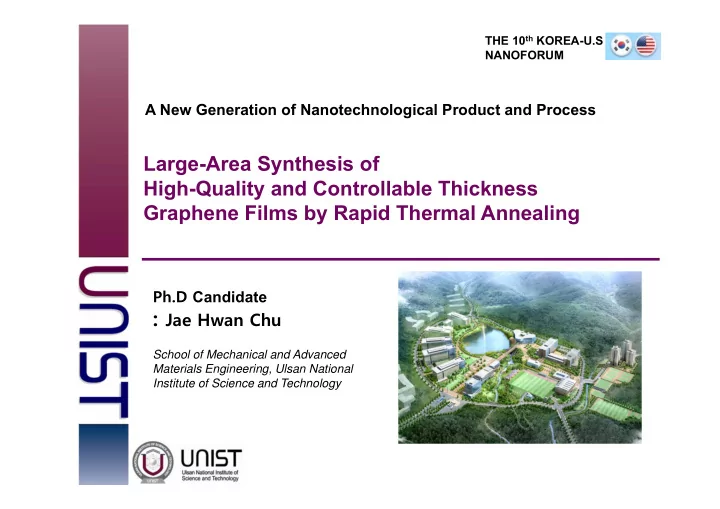

THE 10 th KOREA-U.S NANOFORUM A New Generation of Nanotechnological Product and Process Large-Area Synthesis of High-Quality and Controllable Thickness Graphene Films by Rapid Thermal Annealing Ph.D Candidate : Jae Hwan Chu School of Mechanical and Advanced Materials Engineering, Ulsan National Institute of Science and Technology
THE 10 th KOREA-U.S NANOFORUM Rapid Thermal Annealing (RTA) Nickel – assisted graphene grow th using RTA • Spontaneous formation , Carbon- and oxygen-containing compounds • Few-layer graphene films were formed on a nickel surface
THE 10 th KOREA-U.S NANOFORUM Rapid Thermal Annealing (RTA) -Temperature (800 ~1000 ℃) & Various ambient • Few -layer graphene film s are form ed under vacuum ( ∼ 1 0 -3 Torr) at tem p. ranging from 8 0 0 � and 1 0 0 0 � for 0 .5 – 4 m in • No graphene form w hen inert gases are introduced during the RTA process
THE 10 th KOREA-U.S NANOFORUM Growth mechanism Dominant factor – oxygen evaporation rate 1) Inert gas - RTA No significant change in oxygen concentration → No graphene form 2) Vacuum – RTA Graphene forms in all investigated temperature, along with oxygen evaporation from surface • Presence of Ar or N 2 during RTA m ay lead to a m uch reduced oxygen evaporation rate → The oxygen atoms desorbing from the surface have a finite probability of being reflected back to the nickel surface by collision with Ar or N 2 , as pointed out by Langmuir and Fonda. (Phys. Rev. 43, 401 (1912), (Phys. Rev. 31 (260))
THE 10 th KOREA-U.S NANOFORUM Characterization of graphene at RTA-vacuum The thickness and physical properties of the graphene layers are strongly dependent on the RTA temperature and time.
THE 10 th KOREA-U.S NANOFORUM Conclusion • The m erits of our m ethod are as follow s. 1) Simply grown by annealing the nickel films at high temperature under vacuum 2) The consuming time of process is highly short 3) The thickness of graphene layers is controlled by RTA temperature and time 4) comparable structural and optoelectronic qualities with CVD- graphene
THANK YOU
ACS Appled Materials & Interface 4(3): 1777 (2012) Any other questions?
THE 10 th KOREA-U.S NANOFORUM Supporting information Supporting Information
THE 10 th KOREA-U.S NANOFORUM Experiments (RTA method) • The nickel films - Deposited in com m ercial evaporators ( ~ 1 0 -6 -1 0 -7 Torr) w ith solid Ni( 9 9 .9 9 % ) - Thickness of ~ 1 0 0 nm deposited on a SiO2 ( 3 0 0 nm ) / Si( 1 0 0 ) substrate - The source and stored under atm osphere for a typical period of a few days. • RTA(Rapid Thermal Annealing) -Tem peratures ranging from 8 0 0 o C to 1 ,0 0 0 o C for 0 .5 - 4 m in - Vacuum ( ~ 1 0 -3 Torr) - I n inert gas ( Ar, N 2 ) am bient ( ~ 0 .2 -2 .0 Torr) • How to employ the source of carbon - Trace am ounts of unintentionally introduced carbon and oxygen atom s after Ni deposition
THE 10 th KOREA-U.S NANOFORUM How to make graphene? Table 1. Comparison of different methods for graphene production
THE 10 th KOREA-U.S NANOFORUM Rapid Thermal Annealing (RTA) K. Novoselov, Nature 4 9 0 , 1 9 2 ( 2 0 1 2 ) . • An attractive method • large area graphene synthesis > 6inch CVD • good optical, electrical and method mechanical properties • RTA method • applying various applications - Facile synthesis of large-area Rapid graphene Thermal - A simple and reproducible method Annealing Why should the CVD method be - without intentional carbon- containing precursor improved? 1) Required various parameters 2) Difficult control for growth. 3) Total process time is long. 4) Price.
THE 10 th KOREA-U.S NANOFORUM How to employ the source of carbon - XPS concentration-depth profile of Ni films before RTA process • The presence of Ultrathin Compounds on a Nickel Surface Ni 3 C 283.9 eV C 1s NiCO 3 288.4 eV NiO 529.7 eV O 1s NiCO 3 531.3 eV Ni 3 C 852.9 eV Ni 2p NiO 853.8 eV NiCO 3 854.7 eV Trace am ounts of unintentionally introduced carbon and oxygen atom s after Ni deposition
THE 10 th KOREA-U.S NANOFORUM What makes difference growth condition? - XPS concentration profile 1) As deposition, 2) RTA in N2 at 900 ℃ 1min , 3) RTA in vacuum at 900 ℃ 1min • considerable com positional changes only vacuum am bient • m ost oxygen atom s disappear after the vacuum – RTA process
THE 10 th KOREA-U.S NANOFORUM What makes difference growth condition? - XPS Depth profile 1) As deposition, 2) RTA in N2 at 900 ℃ 1min , 3) RTA in vacuum at 900 ℃ 1min Table 4. the composition(%) of the top surface according to C1s and O1s elements Carbon Oxygen Ambient composition(%) composition(%) As-grown 27.73% 35.68% 25.26% 30.94% RTA in N 2 RTA in vacuum 85.92% 2.36%
Recommend
More recommend